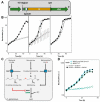Methanol-Essential Growth of Corynebacterium glutamicum: Adaptive Laboratory Evolution Overcomes Limitation due to Methanethiol Assimilation Pathway
- PMID: 32443885
- PMCID: PMC7279501
- DOI: 10.3390/ijms21103617
Methanol-Essential Growth of Corynebacterium glutamicum: Adaptive Laboratory Evolution Overcomes Limitation due to Methanethiol Assimilation Pathway
Abstract
Methanol is a sustainable substrate for biotechnology. In addition to natural methylotrophs, metabolic engineering has gained attention for transfer of methylotrophy. Here, we engineered Corynebacterium glutamicum for methanol-dependent growth with a sugar co-substrate. Heterologous expression of genes for methanol dehydrogenase from Bacillus methanolicus and of ribulose monophosphate pathway genes for hexulose phosphate synthase and isomerase from Bacillus subtilis enabled methanol-dependent growth of mutants carrying one of two independent metabolic cut-offs, i.e., either lacking ribose-5-phosphate isomerase or ribulose-5-phosphate epimerase. Whole genome sequencing of strains selected by adaptive laboratory evolution (ALE) for faster methanol-dependent growth was performed. Subsequently, three mutations were identified that caused improved methanol-dependent growth by (1) increased plasmid copy numbers, (2) enhanced riboflavin supply and (3) reduced formation of the methionine-analogue O-methyl-homoserine in the methanethiol pathway. Our findings serve as a foundation for the engineering of C. glutamicum to unleash the full potential of methanol as a carbon source in biotechnological processes.
Keywords: adaptive laboratory evolution; isotopic labeling; metabolic engineering; methanol; ribulose monophosphate pathway; synthetic methylotrophy.
Conflict of interest statement
The authors declare no conflict of interest.
Figures





Similar articles
-
Production of carbon-13-labeled cadaverine by engineered Corynebacterium glutamicum using carbon-13-labeled methanol as co-substrate.Appl Microbiol Biotechnol. 2015 Dec;99(23):10163-76. doi: 10.1007/s00253-015-6906-5. Epub 2015 Aug 16. Appl Microbiol Biotechnol. 2015. PMID: 26276544
-
Metabolic engineering of Corynebacterium glutamicum for methanol metabolism.Appl Environ Microbiol. 2015 Mar;81(6):2215-25. doi: 10.1128/AEM.03110-14. Epub 2015 Jan 16. Appl Environ Microbiol. 2015. PMID: 25595770 Free PMC article.
-
Engineering Corynebacterium glutamicum for methanol-dependent growth and glutamate production.Metab Eng. 2018 Sep;49:220-231. doi: 10.1016/j.ymben.2018.07.011. Epub 2018 Jul 23. Metab Eng. 2018. PMID: 30048680
-
Genomic organization and biochemistry of the ribulose monophosphate pathway and its application in biotechnology.Appl Microbiol Biotechnol. 2009 Sep;84(3):407-16. doi: 10.1007/s00253-009-2120-7. Epub 2009 Jul 11. Appl Microbiol Biotechnol. 2009. PMID: 19593556 Review.
-
Evolutionary engineering of Corynebacterium glutamicum.Biotechnol J. 2019 Sep;14(9):e1800444. doi: 10.1002/biot.201800444. Epub 2019 Jun 7. Biotechnol J. 2019. PMID: 30927493 Review.
Cited by
-
Metabolic Engineering of Corynebacterium glutamicum for Sustainable Production of the Aromatic Dicarboxylic Acid Dipicolinic Acid.Microorganisms. 2022 Mar 29;10(4):730. doi: 10.3390/microorganisms10040730. Microorganisms. 2022. PMID: 35456781 Free PMC article.
-
Improved Plasmid-Based Inducible and Constitutive Gene Expression in Corynebacterium glutamicum.Microorganisms. 2021 Jan 19;9(1):204. doi: 10.3390/microorganisms9010204. Microorganisms. 2021. PMID: 33478126 Free PMC article.
-
Genomic and Transcriptomic Investigation of the Physiological Response of the Methylotroph Bacillus methanolicus to 5-Aminovalerate.Front Microbiol. 2021 Apr 30;12:664598. doi: 10.3389/fmicb.2021.664598. eCollection 2021. Front Microbiol. 2021. PMID: 33995329 Free PMC article.
-
Adaptive Laboratory Evolution of Microorganisms: Methodology and Application for Bioproduction.Microorganisms. 2022 Dec 29;11(1):92. doi: 10.3390/microorganisms11010092. Microorganisms. 2022. PMID: 36677384 Free PMC article. Review.
-
From a Hetero- to a Methylotrophic Lifestyle: Flash Back on the Engineering Strategies to Create Synthetic Methanol-User Strains.Front Bioeng Biotechnol. 2022 Jun 8;10:907861. doi: 10.3389/fbioe.2022.907861. eCollection 2022. Front Bioeng Biotechnol. 2022. PMID: 35757790 Free PMC article. Review.
References
MeSH terms
Substances
Grants and funding
LinkOut - more resources
Full Text Sources

